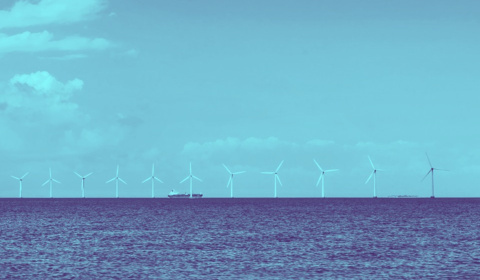
Choosing the right innovations for your sustainable future
The energy transition is top of mind for marine and offshore energy stakeholders, as they search for ways to reduce their consumption and the environmental impact.
For asset owners, this means more than just picking and choosing sustainable solutions. Achieving maritime decarbonization will require a methodical approach to finding the onboard solutions that target specific asset needs.
The energy transition is coming to the maritime industry, as increasing regulations and changing social expectations require stakeholders to implement more sustainable approaches. As the IMO’s 2030 and 2050 targets for reducing greenhouse gas (GHG) emissions draw nearer, asset owners must accelerate decision-making and invest in sustainable technologies.
Today’s maritime market is flooded with potential design, technical and operational solutions to help stakeholders make the transition to a GHG-free future. But asset owners need a reliable way to evaluate the grab bag of solutions currently available and determine the best way to reduce their environmental impact. All solutions come with advantages and challenges, and no one innovation can offer complete decarbonization for an asset.
This is where technical expertise plays a vital role. By methodically assessing which technologies and innovations are safe, reliable and efficient, owners can make optimal decisions for their individual assets.
Assessing innovation from a technical point of view
The maritime industry has identified a variety of solutions, including alternative fuels and propulsion, to achieve energy efficiency and reduce emissions. While liquefied natural gas (LNG) as fuel has been a strong first step, allowing assets to avoid heavy fuel oil, it is only the beginning. Energy sources from biofuels to methane to hydrogen and ammonia are under development for use as marine fuels. Batteries, fuel cells, sails, kites and more are being explored as alternative propulsion methods.
Many of these promising solutions are now undergoing careful scrutiny by technical experts to determine their safety and viability. Feasibility studies and performance evaluations will undergird the development of new innovations, analyzing how new technologies interact with existing ships and offshore units. Each asset presents its own challenges – e.g., transporting hazardous materials, carrying large numbers of passengers, having limited space onboard – for integrating new solutions.
Addressing key areas for environmental improvement
An energy strategy can cover any number of critical sustainability topics for ships and offshore assets:
- Emissions reduction: limiting GHG emissions is the first concern for most asset operators, preventing harmful substances (e.g., carbon, methane) from escaping into the atmosphere. Burning alternative fuels, measuring fuel consumption and using weather routing technology are some ways to limit air emissions.
- Energy efficiency: vessel design experts have developed efficient methods to improve ship design, including optimizing the hull, bulb optimization, trim control, and rudder and propeller integration. While today’s owners and operators recognize the importance of increasing energy efficiency to reduce pollution, this will not be enough in itself.
- Noise reduction: underwater radiated noise (URN) and vibrations can damage the marine environment, disrupting animals’ migratory patterns and ability to communicate. By measuring noise and vibration levels produced by assets in operation, owners can target areas for improvement (e.g., engines, propellers) and decrease the level of environmental disturbance.
- Inventory of Hazardous Materials (IHM): when ships reach the end of their operating lives, proper recycling is key to keeping hazardous materials from polluting the environment. In line with the European Ship Recycling Regulation (EU SRR), shipowners must have a certified IHM onboard throughout vessel life. Additionally, they need to develop an approved Ship Recycling Plan. Shipowners must rely on third party experts to put all these requirements in place.
- Ballast Water Management (BWM): Ships carrying ballast water run the risk of introducing invasive species into the marine environment as they travel from one destination to another. To meet international regulations and prevent water-based pollution, ships must undergo assessment for design, equipment and treatment systems. Owners must then develop an appropriate BWM Plan and Management System.
- Scrubber integration: to be in line with the IMO’s Global Sulphur Cap, scrubbers are an option. To determine whether to install a scrubber, owners need to make calculations based on price and ROI, as well as structural limitations and fatigue.
- Emissions monitoring: Operators must monitor CO2 emissions released for any voyages to or from EU Member State ports, keeping records on both per-voyage and annual bases. For IMO Global Sulphur Cap 2020 compliance, vessels operating within Emission Control Areas (ECAs) and Sulphur Emission Control Areas (SECAs) must use fuel oil with a maximum sulphur content of 0.10%. Once relevant data has been collected, operators need to develop and deliver reports to the proper authorities.
Steering asset owners through the energy transition
The maritime industry moves slowly, but when it evolves, the results can often be rapidly adopted across the sector. A decade ago, LNG as fuel was not considered a feasible large-scale solution. Today, it is a standard for cruise ships, containerships, gas carriers, bunkering ships and more.
However, the shift from traditional heavy fuel oil to LNG represents only the first stage of the energy transition. The move to carbon-neutral solutions and energy-efficient assets will depend on a wave of innovations: improved storage systems, connected technologies, smaller, more powerful batteries, etc.
BV Solutions M&O provides clients with vital technical expertise, feasibility studies and performance evaluations to assess energy consumption and emissions. While the next stage of the energy transition is still taking shape, BV Solutions M&O is keeping its focus on guiding clients safely through a time of change. We are putting our energy, experience and technical insight into helping asset owners, operators and managers take hold of and contribute to a greener future.
Global Strategic Sales Director
BV Solutions M&O
Innovation will be the main driver of the energy transition, but assessing new solutions can be a distinct challenge for maritime stakeholders. Our goal at BV Solutions M&O is to improve this process, making innovations accessible and understandable, and nudging our clients in the right direction. Think of us as an agile tugboat, guiding big assets into the future!
